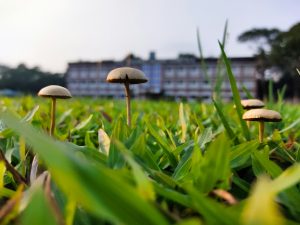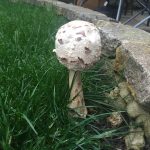Mushrooms on Your Lawn: What They Mean and How to Manage Them
If you’ve noticed small clusters of mushrooms or toadstools appearing in your lawn, don’t panic — they’re a common and natural sight across the UK. In most cases, mushrooms are not a sign of disease but an indicator that your soil is healthy and full of life. Still, understanding why they appear and how to manage them is key to maintaining a tidy, well-balanced lawn.
Why Mushrooms Appear in Lawns?
Mushrooms are the fruiting bodies of underground fungi, which thrive in damp, nutrient-rich soil. Their presence shows that organic matter is breaking down — a normal part of the ecosystem.
Common causes include:
Moisture and shade: Fungi love damp, shaded spots.
Decaying organic matter: Buried wood, old roots, or thatch layers feed fungi.
Poor drainage: Compacted soil or heavy clay retains water.
New turf: Disturbed soil often triggers dormant spores.
Are Mushrooms Harmful to the Lawn?
In most cases, mushrooms are harmless — they don’t damage the grass. In fact, they help recycle nutrients back into the soil.
However, they can:
Make the lawn look untidy
Pose a risk if children or pets touch or eat them
Indicate deeper issues such as poor drainage or low light
If mushrooms are recurring or widespread, it’s worth improving your lawn’s growing conditions.
How to Control and Prevent Mushrooms
1. Improve Drainage
Aerate compacted areas with a hollow-tine aerator or garden fork. This allows water to move freely and prevents the damp conditions fungi love.
2. Increase Sunlight and Airflow
Trim overhanging trees and shrubs to allow more light and airflow — both natural deterrents for fungal growth.
3. Remove Organic Debris
Rake away leaves, dead roots, and thatch. Fungi feed on decaying matter, so reducing it limits their food source.
4. Mow and Collect Clippings
Keep your grass well-trimmed and remove clippings after mowing. Collect and bin mushrooms rather than composting them to prevent spore spread.
5. Maintain Lawn Health
Feed your lawn regularly with a balanced fertiliser, overseed thin patches, and water deeply but infrequently. A dense, strong lawn resists fungal growth naturally.
When to Expect Mushrooms?
Mushrooms most often appear in spring and autumn, when the soil is warm and damp. After periods of rain, you might see sudden flushes — especially in shaded or compacted areas. In newly laid lawns, this is temporary and typically fades as the turf matures.
Professional Lawn Treatment Solutions
As professional lawn specialists, we can:
Aerate and scarify your lawn to improve airflow and drainage
Apply seasonal fertilisers to promote healthy grass growth
Assess shaded or damp areas to reduce fungal conditions
Offer long-term lawn treatment plans tailored to your soil type
Healthy soil equals healthy grass — and fewer mushrooms.
Final Thoughts
Mushrooms are a natural part of any living lawn. Their presence usually means your soil is biologically active — a positive sign. But with proper aeration, balanced feeding, and regular maintenance, you can keep your grass lush, even, and fungus-free.







